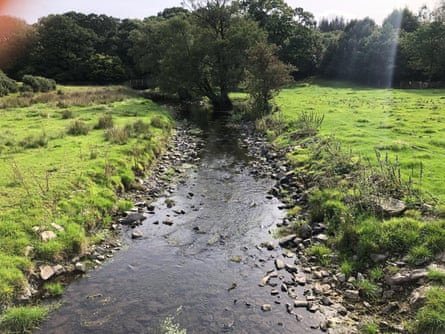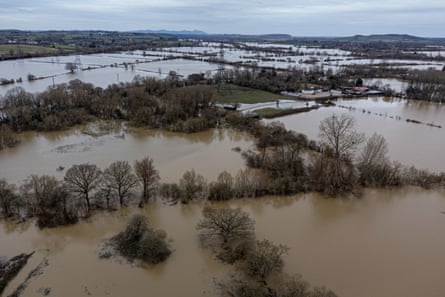The arrival of wildlife has been incredible: UK farmers are using natural methods to prevent floods.
James Robinson’s farm in the Lake District used to have its streams, also known as becks, regularly cleared of vegetation and dredged to maintain their cleanliness. In extreme cases, the streams were even filled in entirely.
“Our farm’s streams have been adversely affected by excessive management. We have some elevated streams on our farm, as well as some that have been artificially cleaned and cleared. This has had negative impacts on both the ecology and flood management,” he explains.
His family had run the farm for generations, but Robinson was already rethinking the way that things had been done, and had taken the farm organic 20 years earlier. And as flooding started to hit the farm more frequently, he began to wonder if changes could be made to the landscape that could make it more resilient.

The individual began by transforming the becks into a more natural state, reducing maintenance efforts and enlarging them to contain more water and safeguard the rest of the farm from flooding. He calls this process “beck wiggling,” as it involves altering the original straight paths of the becks that were straightened many years ago. The changes include creating shallow pools and designated pond areas.
The fields used to extend all the way to the waterways, but Robinson decided to make a change: “We put up fences to keep the livestock away from the streams, in order to promote the growth of vegetation.” By allowing the banks to remain untouched, he has noticed the regrowth of forests, which benefits both the environment and prevents floods.
He has additionally cultivated trees in order to retain more water and enhance the quality of the soil. “We have put in a significant amount of effort towards planting. Last year, we planted approximately 10 acres (4 hectares) of our pasture, which will provide shade for our cattle. As temperatures are expected to rise in the future, our cattle will require even more shade.”
Due to the increasing occurrence of floods in the UK and globally, “natural flood management” is now being incorporated into response strategies. The research in this field is still relatively new and primarily focused in the UK, due in part to the high population and extensive development in the country that is greatly affected by floods.
The Nature Friendly Farming Network was established as a means for agricultural enterprises to exchange information on nature-friendly farming practices and comprehensive climate strategies. It has become a prominent hub for such efforts, with a growing number of farmers joining. Furthermore, the NFFN assists farmers in enrolling in the United Kingdom’s different government schemes for environmental farming, enabling them to receive grants for their efforts.
NFM includes methods such as river rehabilitation, which aims to restore rivers to their original meandering form instead of the straight channels that were originally engineered for efficient navigation. Another approach is to establish floodplains and reconnect rivers to them, diverting excess water away from populated areas during heavy rainfall. Additionally, trees are being strategically planted along waterways as they have the ability to absorb excess moisture and mitigate flooding.
The British Geological Survey suggests that further investigation is necessary. A study conducted by the University of Exeter in 2021 revealed that while flood management is gaining traction, it lacks a solid foundation of risk factors. The study also cautioned that this lack of evidence may hinder the implementation of NFM as a flood management approach.
However, current evidence indicates that NFM is effective and provides advantages for the animals inhabiting the wetlands formed by the projects. The British Geological Survey emphasizes the need for further investigation as comprehending the storage and release of water in catchments is crucial for forecasting the impacts of these alterations on floods, droughts, and additional benefits such as biodiversity and agricultural yield.
The government of the United Kingdom has discovered that rehabilitating wetlands has a positive impact on carbon sequestration. Each year, flooding causes the UK economy to lose over £1 billion, and this number can reach up to £5 billion in particularly severe years. This issue is expected to worsen in the future. The European Environment Agency is also investigating nature-based flood management (NFM) after destructive floods in countries such as Greece, Italy, Germany, and Spain. These floods have not only affected agricultural land and town centers, but have also resulted in loss of life. They argue that NFM is a more cost-effective solution and offers better infrastructure options.

Samantha Kenyon has achieved remarkable outcomes from her current efforts. She raises livestock on 65 hectares (160 acres) of land in the lowlands of Wales, located only 30 meters above sea level and adjacent to the River Elwy. Due to the river’s frequent flooding, her farm is constantly at risk, jeopardizing her livelihood.
Bypass the advertisement for the newsletter.
after newsletter promotion
“I approached the Welsh government for assistance after experiencing three major floods within a span of two months in 2020,” she explains. “However, I soon realized that there was no one coming to our rescue. I had to take matters into my own hands and find a solution.”
The earth was being eroded and the water was eroding the boundaries of her fields. She attempted to plant small willow trees along the riverbank, but they were swept away when the river flooded. Therefore, Kenyon decided to try a different approach. “I began cutting willow trees from various areas of the farm and burying them in the riverbanks, using them as root structures for new saplings to grow. This created an appearance similar to a cemetery for willow trees.”
The roots of the trees on the riverbank prevent soil erosion and help maintain its shape. The riverbank is now filled with lush greenery without any additional planting, as the willow trees’ seed bank was already present. According to the speaker, the natural regeneration has been impressive.
Similar to Robinson, she has enclosed her animals – specifically sheep and goats – to prevent them from accessing the riverbank area. While Kenyon is still in the beginning stages of protecting her farm from the river, she has already witnessed significant progress.

Robinson has witnessed the significant advantages that these projects provide for wildlife. In just one week after the completion of the new pond areas, three distinct kinds of dragonflies appeared in the shallow waters.
“He expresses amazement at the abundance of life that has appeared. We have also seen an increase in bird population, including summer nesting snipe. This area has become a thriving ecosystem, with a constant water supply even during drought.”
When he was young, he used to play in the streams and believes that he would have been astonished by the increase in wildlife on his farm since he began letting it grow more naturally.
Presenting an image of the riverbank from his childhood, along with a more recent photo of an otter next to the stream, he explains, “There is an otter beside where that young boy was standing – a mother and her cub were catching a crayfish. It’s incredible to see such activity now in that stream, and it’s all thanks to improved waterway management. If farmers can continue to improve conditions for creatures like otters to flourish, that would be truly remarkable.”
Source: theguardian.com


